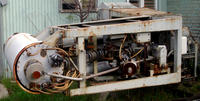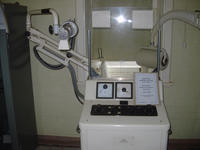
South Australian Medical Heritage Society Inc
Website for the Virtual Museum
Home
Coming meetings
Past meetings
About the Society
Main Galleries
Medicine
Surgery
Anaesthesia
X-rays
Hospitals,other organisations
Individuals of note
Small Galleries
Ethnic medicine
- Aboriginal
- Chinese
- Mediterran
Adelaide's First Linear Accelerator
Acknowledgements:
We are most grateful to Bernard Vaughan for allowing us to use his presentation on the
first linear accelerator in Adelaide.
Since its humble beginning, radiotherapy depended on the application of radium needles, and the production of X-rays by "Deep" and "Superficial X-ray" generators. The latter were very similar to the diagnostic X-ray machines, except operating for longer exposures at a reduced amperage, having large fixed anodes, and a continuous circulation of oil for cooling the tube. The "Superficial X-ray" machines operating at a lower kilovoltage were used for the treatment of skin lesions, while the "Deep X-ray" therapy machines operated at 250 kilovolts. Nevertheless, the "Deep" therapy produced considerable damage to the skin and tissues overlying the treated tumour.
In the late 1940's, the theoretical advantage of very high voltage therapy units was under discussion in the UK. An impressive group of radiation physicists had drawn up specifications for a 4 million electron volt unit, designed to produce the most powerful and hardest of rays. Strongly advised by their physicist, Mr B. W. Worthley, the local Anti Cancer Council, realising that the government could hardly agree to order so expensive unit still only on the drawing board, decided to appeal to the public for the money to buy such a machine as a "Linear Accelerator" (LINAC). By March 1957 the machine was installed and working in a specially designed building. Within months the machine had become the workhorse of the department, backed up by 2 cobalt beam units. Credit must be given to the engineers of Metropolitan Vickers (Manchester), and the local physicist John Tooze for maintaining the machine for over 25 years when it became the longest working linear accelerator in the world. The first Metropolitan Vickers Linear Accelerator was working in the Christie Hospital, Manchester in 1955.
The linear accelerator uses microwave technology (similar to that used for radar) to accelerate electrons in a part of the accelerator called the "wave guide", then allows these electrons to collide with a heavy metal target. As a result of the collisions, high-energy x-rays are scattered from the target. A portion of these x-rays are collected and then shaped to form a beam that matches the patient's tumour. The beam comes out of a part of the accelerator called a gantry, which rotates around the patient. The patient lies on a moveable treatment couch, and lasers are used to make sure the patient is in the proper position. Radiation can be delivered to the tumour from any angle by rotating the gantry and moving the treatment couch.

